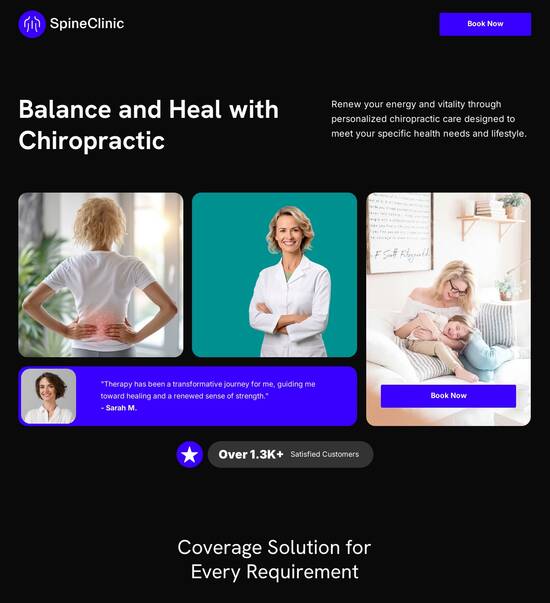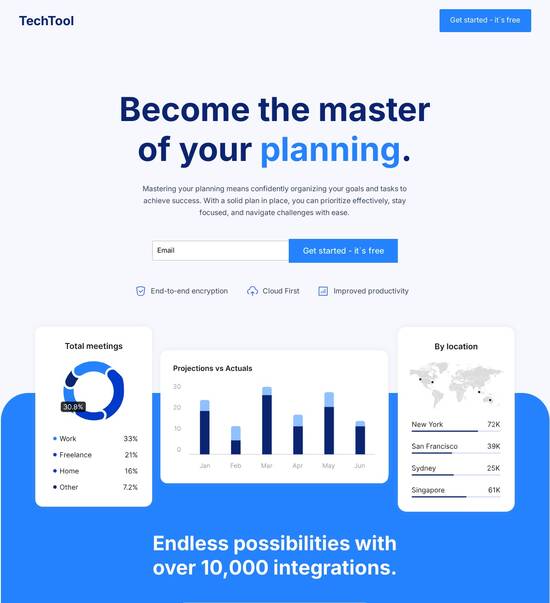
Landing page template for emergency response teams
Use TemplateAbout template
Collaborate and optimize like never before with our landing page templates for emergency response teams. Ready to streamline your workflow?
Recommended templates

Easy to build without coding
With the intuitive drag-and-drop builder, anyone on your team can create high-converting pages without any knowledge of code or design. Make enhancements to your landing page with custom widgets using Javascript, HTML/CSS, or third-party scripts.

Multiple layouts for any industry and goal
Select from 500+ landing page layouts built to boost conversions across industry-specific scenarios. Customize them by adjusting fonts, adding images, and generating on-brand content with the AI assistant. Quickly scale with Instablocks® and Global Blocks that you can save, reuse, and update globally.

Loads fast and looks polished on any device
Every template is responsive, which means they present professionally on any device and load blazingly fast with our Thor Render Engine. You can also power them up with Google AMP technology to deliver an unparalleled mobile experience and drive higher conversions.

Robust analytics & experimentation
Get real-time updates and reporting across all your devices, showing the number of visitors, conversions, cost-per-visitor, and cost-per-lead. Launch AI-powered experiments, run A/B tests, and use heatmaps to analyze user behavior, then optimize your landing page to maximize conversions.







Easy to build without coding
With the intuitive drag-and-drop builder, anyone on your team can create high-converting pages without any knowledge of code or design. Make enhancements to your landing page with custom widgets using Javascript, HTML/CSS, or third-party scripts.
Multiple layouts for any industry and goal
Select from 500+ landing page layouts built to boost conversions across industry-specific scenarios. Customize them by adjusting fonts, adding images, and generating on-brand content with the AI assistant. Quickly scale with Instablocks® and Global Blocks that you can save, reuse, and update globally.
Loads fast and looks polished on any device
Every template is responsive, which means they present professionally on any device and load blazingly fast with our Thor Render Engine.
Robust analytics & experimentation
Get real-time updates and reporting across all your devices, showing the number of visitors, conversions, cost-per-visitor, and cost-per-lead. Launch AI-powered experiments, run A/B tests, and use heatmaps to analyze user behavior, then optimize your landing page to maximize conversions.
All the features you need to build lead-generating landing pages
Explore more featuresLearn how to build top-performing landing pages for any goal
FAQs
Leading the way in building high-performing landing pages





An effective landing page template for emergency response teams
Utilizing an effective landing page template is essential for emergency response teams looking to quickly communicate critical information. With Instapage, you can create high-converting landing pages that save time and enhance communication during emergencies, ensuring teams can operate efficiently and effectively.
Understanding the unique needs of emergency response
Emergency response teams face a set of unique challenges, including rapid information dissemination and real-time updates. Utilizing a specialized landing page template can streamline communication with the public and within teams. Here’s how to tailor a template for maximum effectiveness:
- Clear messaging: Ensure that the template includes concise messaging that communicates urgency.
- User-friendly design: A clean layout with intuitive navigation ensures that visitors can find information quickly.
- Accessibility features: Integrating accessibility standards allows all members of the community to access vital information.
Step 1: Select a suitable template
Choosing the right landing page template is your first step toward effective communication. Instapage offers over 100 high-converting templates that are ready to customize for your needs.
- Emergency announcement templates: Designed to quickly relay crucial information regarding emergencies.
- Resource pages: Providing links to local resources, updates, and safety protocols.
- Feedback forms: Collecting user feedback allows for real-time improvements and updates.
Step 2: Customize with relevant content
Now that you've selected a template, it's time to fill it with engaging, relevant content. Use language that resonates with your target audience, utilizing personalized messaging techniques.
- Dynamic text replacement: Tailor messages for specific demographics, informing them about their unique roles during an emergency.
- Visual aids: Incorporate images or videos to convey important information visually and draw attention.
- Calls to action: Use clear calls to action that encourage users to act, such as 'Get Help Now' or 'Report an Incident.'
Step 3: Optimize for performance
Once the landing page is set up, optimizing it to ensure it performs under pressure is crucial. Instapage’s built-in analytics and A/B testing tools make it easy to assess what's working.
Regularly reviewing performance metrics allows for immediate adjustments to enhance effectiveness during evolving situations.
In conclusion, leveraging Instapage's landing page templates specifically designed for emergency response teams can significantly enhance your team's operational efficiency and communication.
Start your free trial today and see how Instapage can elevate your emergency response capabilities!
People also ask about Landing page template for emergency response teams
Empowering emergency response teams through customized landing pages
Overview of the vital role of landing pages in emergency communication
In crisis situations, effective communication can be the difference between chaos and control. Landing pages serve as a critical tool for emergency response teams, providing a centralized hub for information dissemination. These pages allow responders to quickly share vital updates, resources, and instructions to help communities navigate through difficult times. A well-constructed landing page can ensure that users receive timely and accurate information when they need it most.
An effective landing page is particularly invaluable during moments when traditional communication methods may falter, such as during power outages or internet disruptions following a natural disaster. This central location enables response teams to quickly relay crucial messages, enhance situational awareness, and offer reassurance. Therefore, the importance of tailored landing page templates that meet the diverse needs of emergency responders cannot be overstated.
Key features of landing page templates for emergency response
When developing landing page templates for emergency response teams, several key features come into play. These features ensure that the templates can adapt to a variety of crises, providing both scalability and ease of use. By prioritizing adaptive design, templates can efficiently serve different situations, whether it's a natural disaster, public health emergency, or any other impending crisis.
Scalability for different crises: Templates must accommodate the requirements of various scenarios, ensuring that response teams can swiftly adapt their messaging and resources.
Responsive design: It is essential that landing pages are accessible on all devices, including smartphones and tablets, to reach the widest audience possible during emergencies.
Moreover, pre-built federal and local protocols can enhance the templates by incorporating guidelines from organizations like FEMA and aligning with local regulations. These templates should feature user-friendly interfaces, making compliance accessible and manageable for response teams.
Optimizing communication with targeted messaging
Crafting effective and urgent calls to action is paramount for landing pages designed for emergency response. During crises, engaging users immediately can prompt swift actions, such as evacuating areas, seeking shelter, or accessing necessary resources. Clarity in communication is essential—response teams should utilize concise, actionable language that guides users on what steps to take next.
Importance of immediate engagement during crises: When lives are at stake, response teams must communicate clear, direct instructions to mobilize community action.
Strategies for effective messaging: Use of plain language, including larger fonts and bold visuals, can help ensure critical information is accessible.
Personalized messaging can maximize outreach ensures that diverse audiences, from affected communities to potential volunteers, are addressed effectively. Leveraging segmentation tools allows response teams to customize messages and prioritize communications based on individual needs and circumstances.
Streamlined information dissemination
The capability to provide easy access to critical resources is a hallmark of effective landing pages for emergency response. Features that enable rapid updates to emergency information can keep the community informed as situations evolve. This includes integrating interactive elements like real-time maps showing evacuation routes or safety zones, which can guide individuals on where to go.
Rapid updates: Allowing response teams to quickly refresh and alter information ensures communities always have the latest guidance.
Embedding interactive maps and real-time data: This feature ensures users can visualize their surroundings and plan accordingly.
Additionally, integrating multi-channel communication capabilities into these landing page templates extends their reach. By syncing with social media platforms and email alerts, emergency messages can penetrate various channels, ensuring a more comprehensive community engagement strategy.
Engaging users with compelling visuals
Utilizing high-quality images and graphics is crucial in engaging users on landing pages. Compelling visuals can capture attention and enhance the credibility of the information being presented. It’s imperative to select images that not only reflect the severity of the situation but also encourage empathy and action from the viewer.
Best practices for selecting impactful images include using photographs that depict real situations or community involvement. This adds a level of authenticity that can encourage action.
Incorporating interactive elements, such as surveys or volunteer registration systems, can enhance user engagement and prompt action during emergencies.
Furthermore, using countdown timers for relevant events or deadlines can help create urgency. This serves as a prompt for individuals to act quickly—be it for evacuation notices or vital resource application deadlines.
Advanced analytics for continuous improvement
Tracking visitor engagement and behavior on landing pages provides emergency response teams with critical insights into how users interact with their content. By utilizing analytics tools, teams can monitor which areas of the page are garnering the most attention and how effectively the messaging resonates.
Tools available for monitoring user interactions include heatmaps, which visually represent where users click and spend their time.
Interpreting this data allows teams to refine and enhance their strategies for future responses.
A/B testing different template designs and messaging can further optimize these pages for maximum effectiveness. By evaluating which variants result in better user responses, teams can iterate and develop resource materials that meet user needs.
Building trust and credibility with stakeholders
In times of crisis, trust is paramount. Landing pages can foster credibility by showcasing organizational values and expertise. This can be achieved by integrating testimonials from individuals who benefited from previous emergency responses or presenting detailed case studies.
Integrating testimonials offers social proof of the organization's effectiveness and commitment, enhancing public confidence in their response efforts.
Transparent communication about response efforts and available resources helps to build a solid foundation of trust with the community.
Moreover, ensuring compliance and security in your landing page's design is essential. User data protection should be a priority, and transparency in how this data is handled builds further trust in the organization’s commitment to the community.
Best practices for creating effective landing pages for emergencies
Creating effective landing pages for emergencies involves simplifying navigation and information layout. An intuitive design is crucial—it should avoid overwhelming users with excessive information while still providing them with the necessary details to act accordingly. Important information should be structured for quick comprehension, ensuring users can locate what they need immediately.
Organizing content in clear sections can improve readability and usability during moments of stress.
Regular updates and maintenance protocols should also be established to keep content relevant and accurate throughout the duration of a crisis.
Having a routine for refreshing content is vital, particularly as situations evolve. This process ensures that communication remains accurate and helps maintain community trust in emergency response teams.
Real-world applications of landing page templates for crisis situations
Various organizations have successfully implemented landing page templates in their crisis response strategies, showcasing their effectiveness. For instance, during natural disasters, several municipalities have leveraged these templates to streamline information sharing and community engagement. By analyzing such implementations, organizations can glean key takeaways and lessons that may inform future strategies.
Case studies of successful implementations reveal common themes: clear messaging, timely updates, and community involvement were pivotal.
Innovations in technology continue to shape emergency response. From mobile-friendly designs to real-time analytics, adapting these roles ensures the improvement of community readiness.
Looking forward, organizations must remain agile and consider how new technological developments can enhance response strategies. By staying ahead of trends, response teams can ensure they are prepared for future crises.
Community engagement and feedback mechanisms
Encouraging visitor interaction on landing pages strengthens community ties and promotes participation during crises. Gathering community input is essential; feedback can be invaluable for tailoring future responses to better serve the needs of affected populations. This iterative process creates a loop where community experiences contribute to improved emergency strategies.
Methodologies for gathering feedback—such as surveys and discussion forums—can add powerful insights into community perceptions and needs.
Building a network of support and collaboration among local organizations can enhance the overall effectiveness of response efforts, pooling resources, and sharing knowledge.
This collaborative approach not only strengthens individual responses but fosters a collective action mentality, reinforcing community resilience and preparedness for any future crises.
Ready to skyrocket conversions?
Supercharge your ad campaigns with high-performing landing pages
Get started














